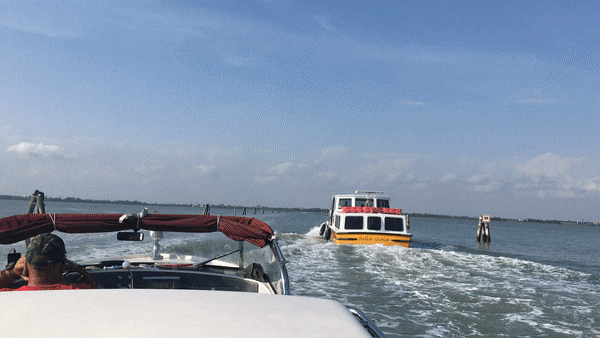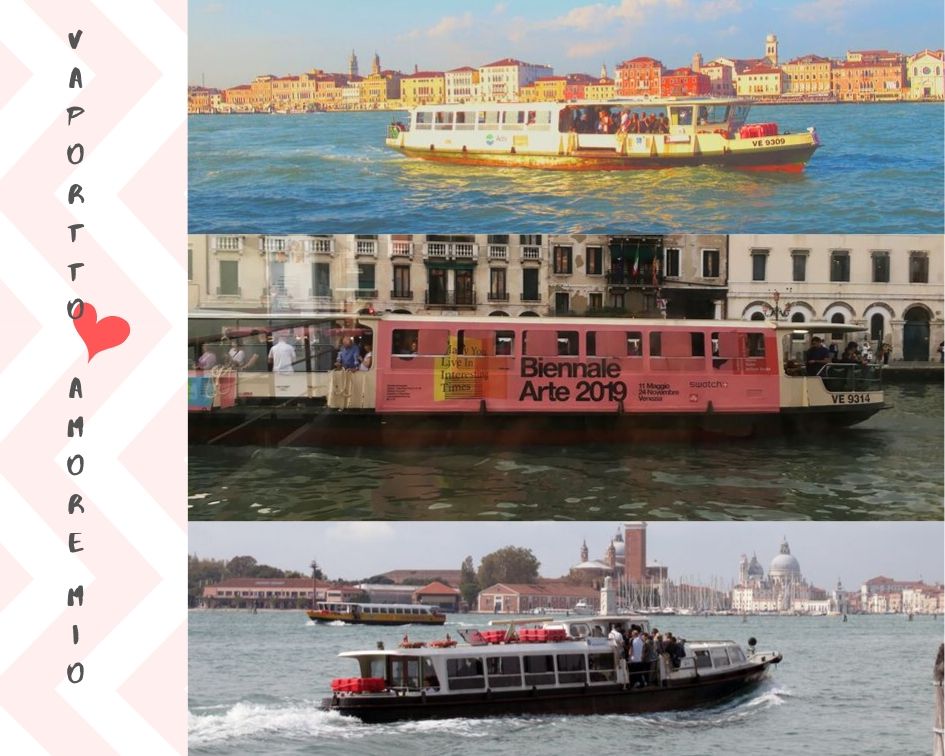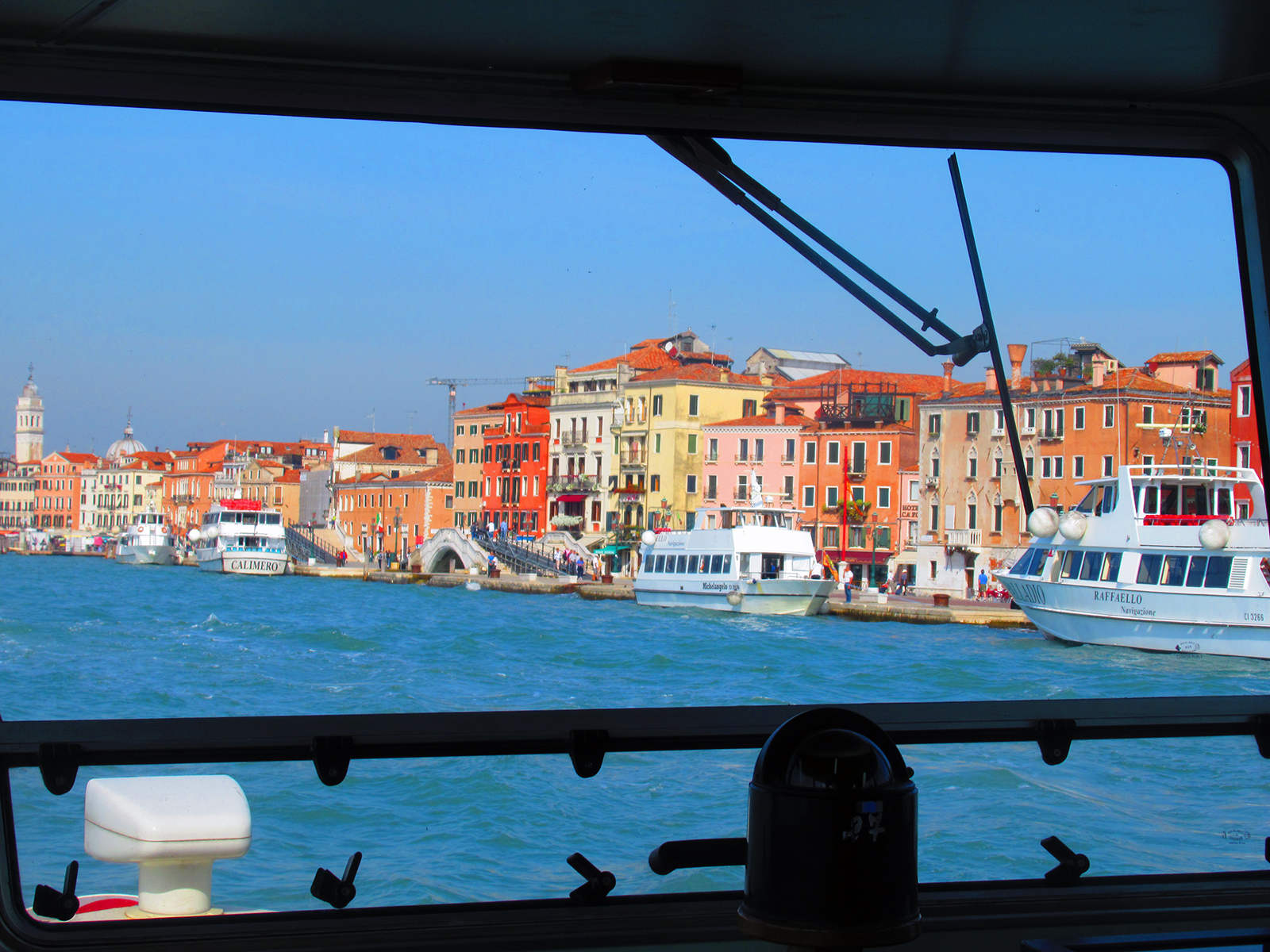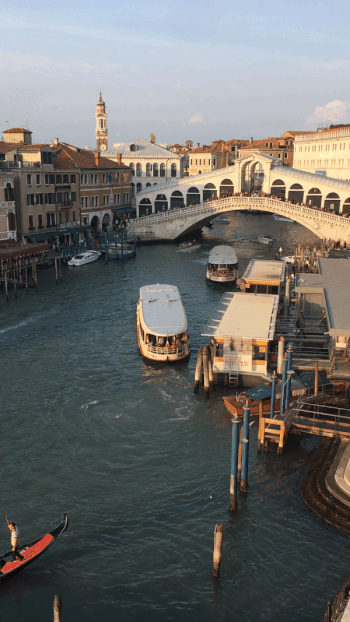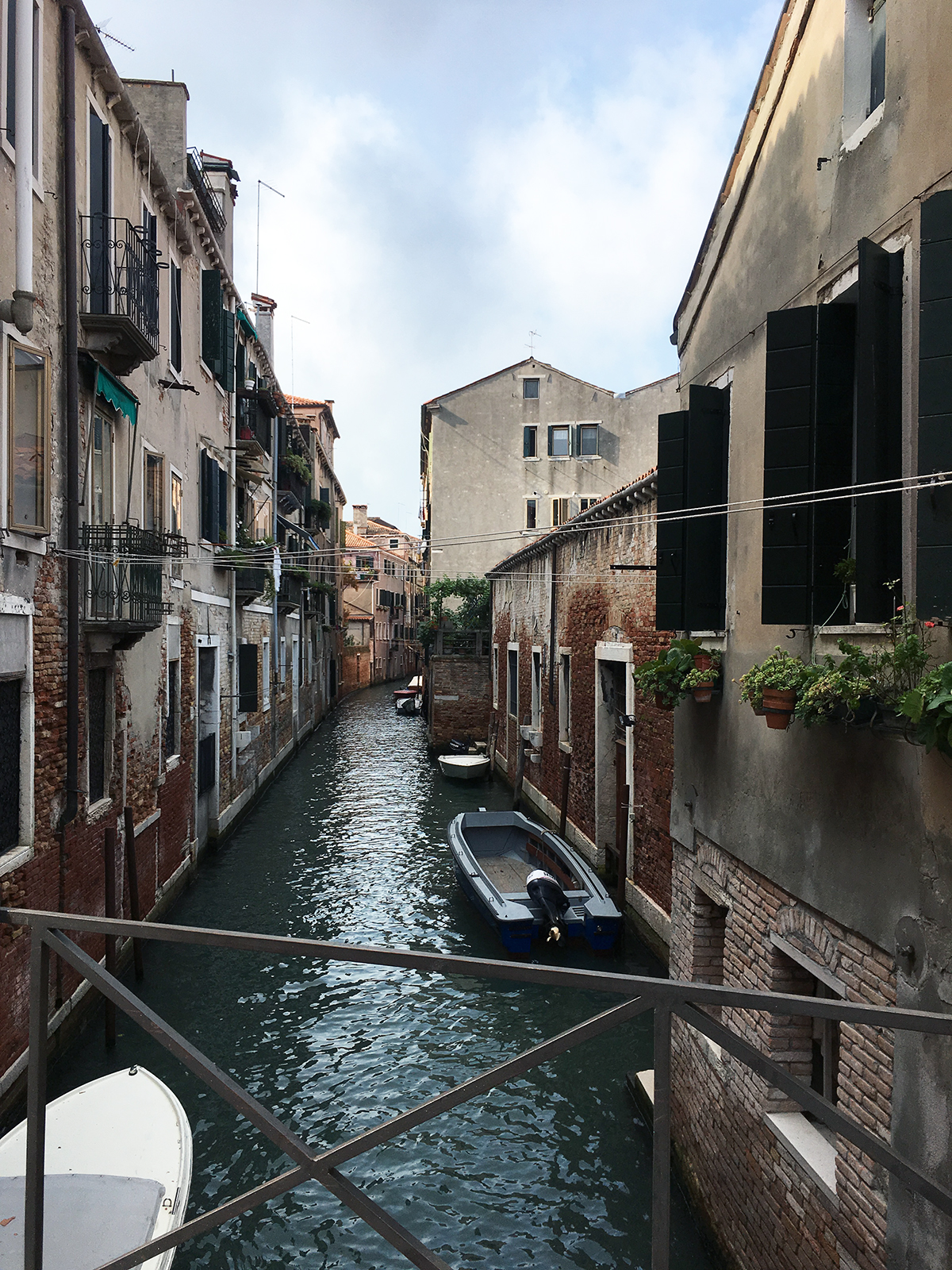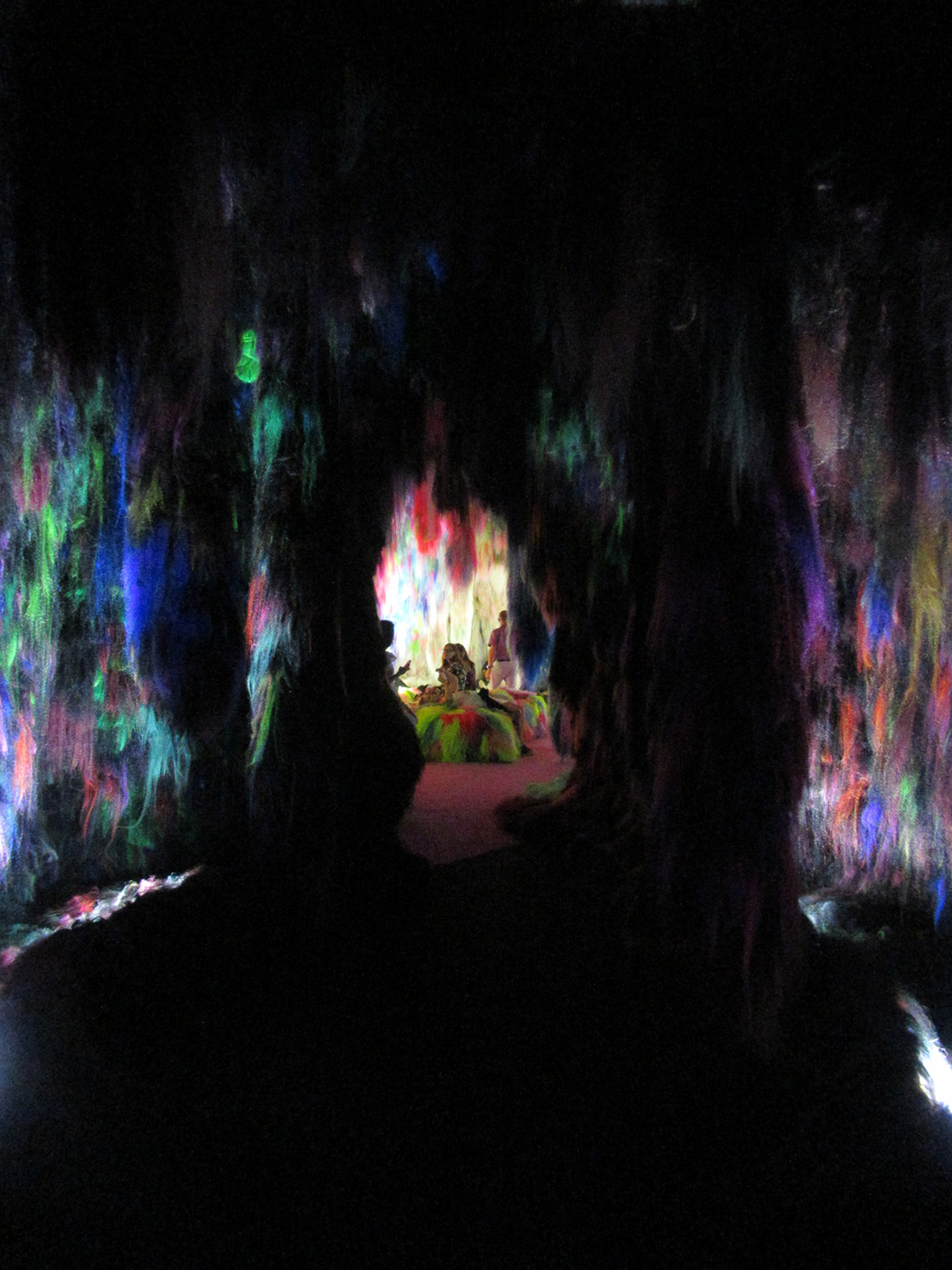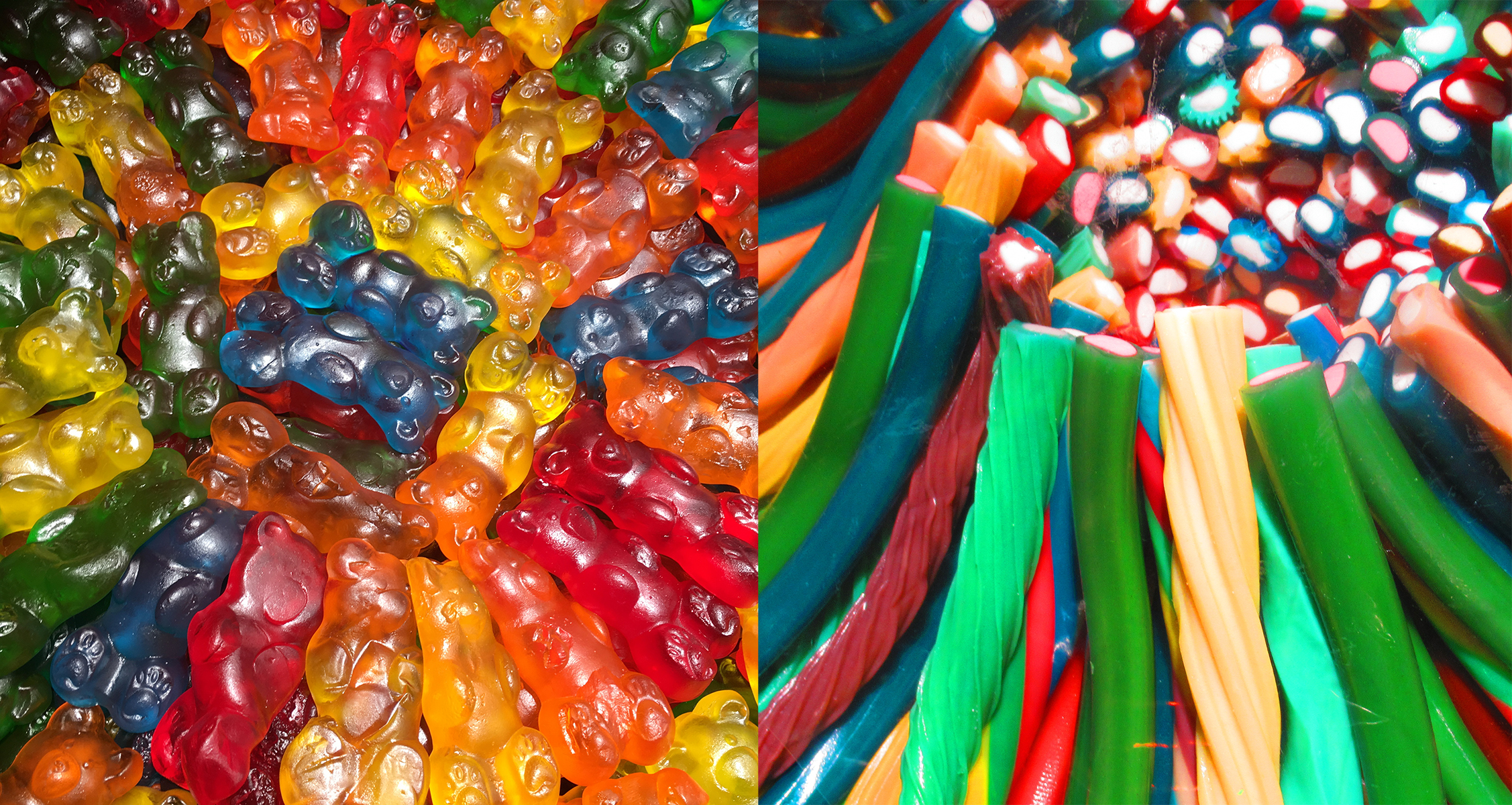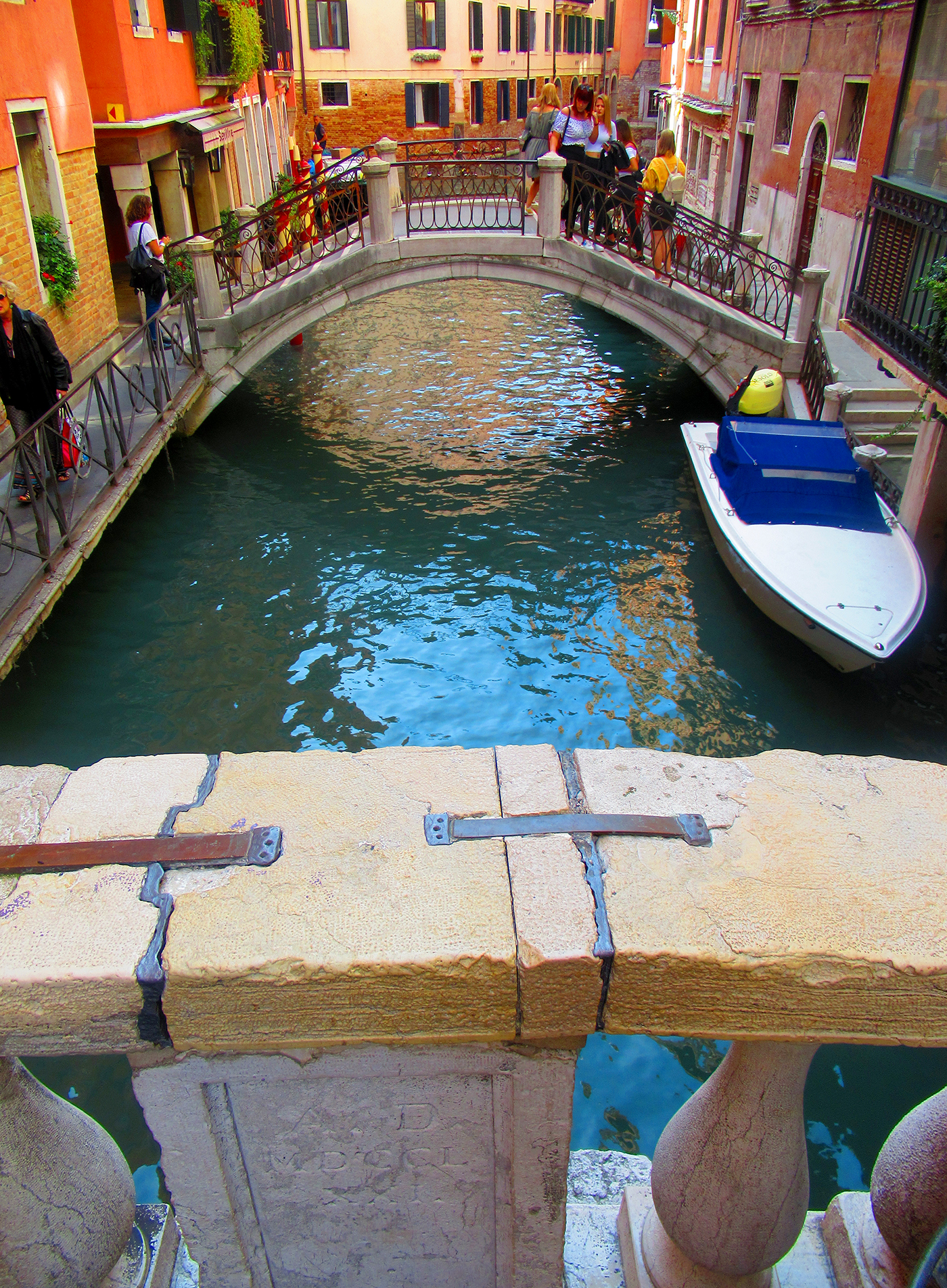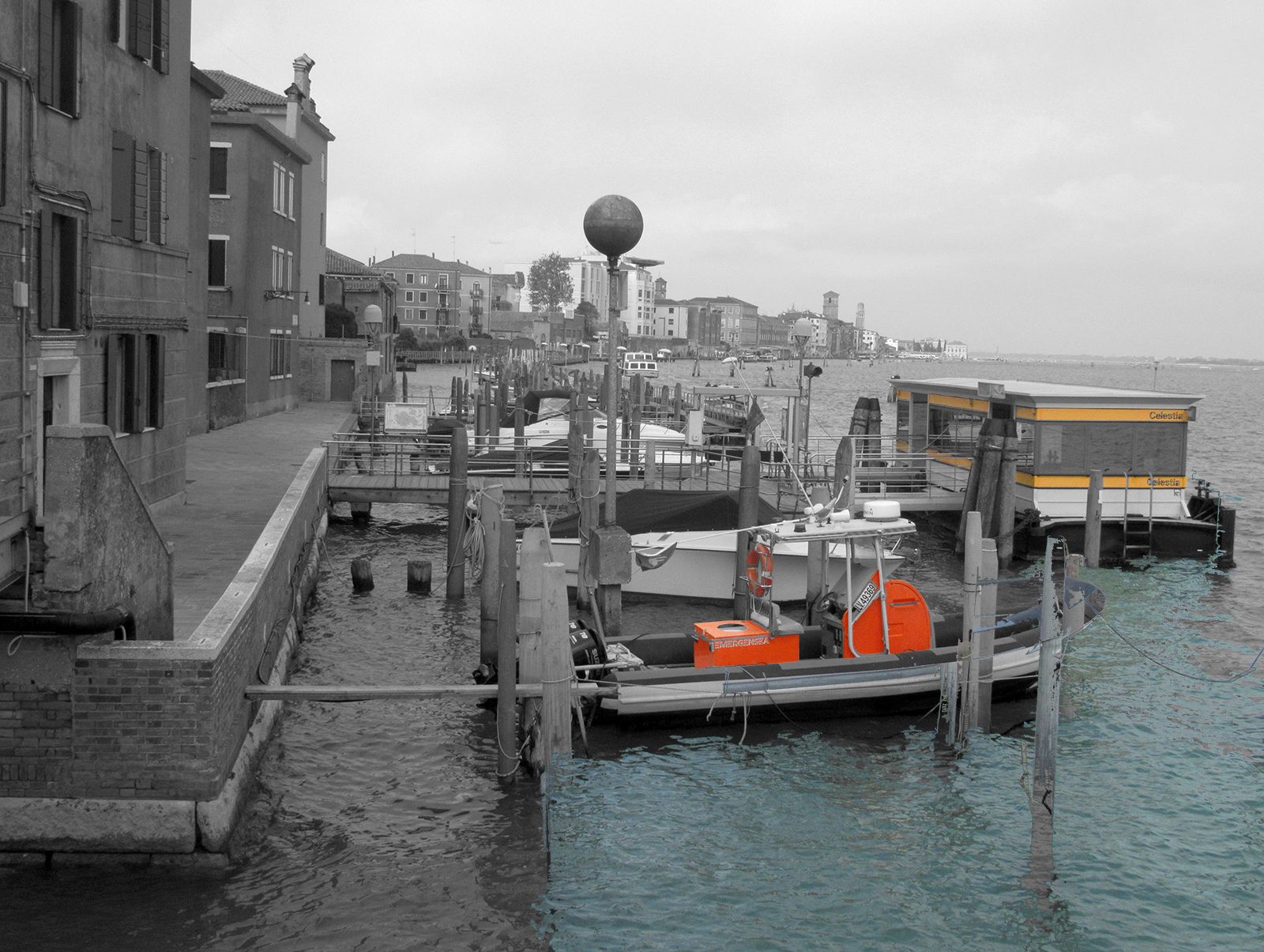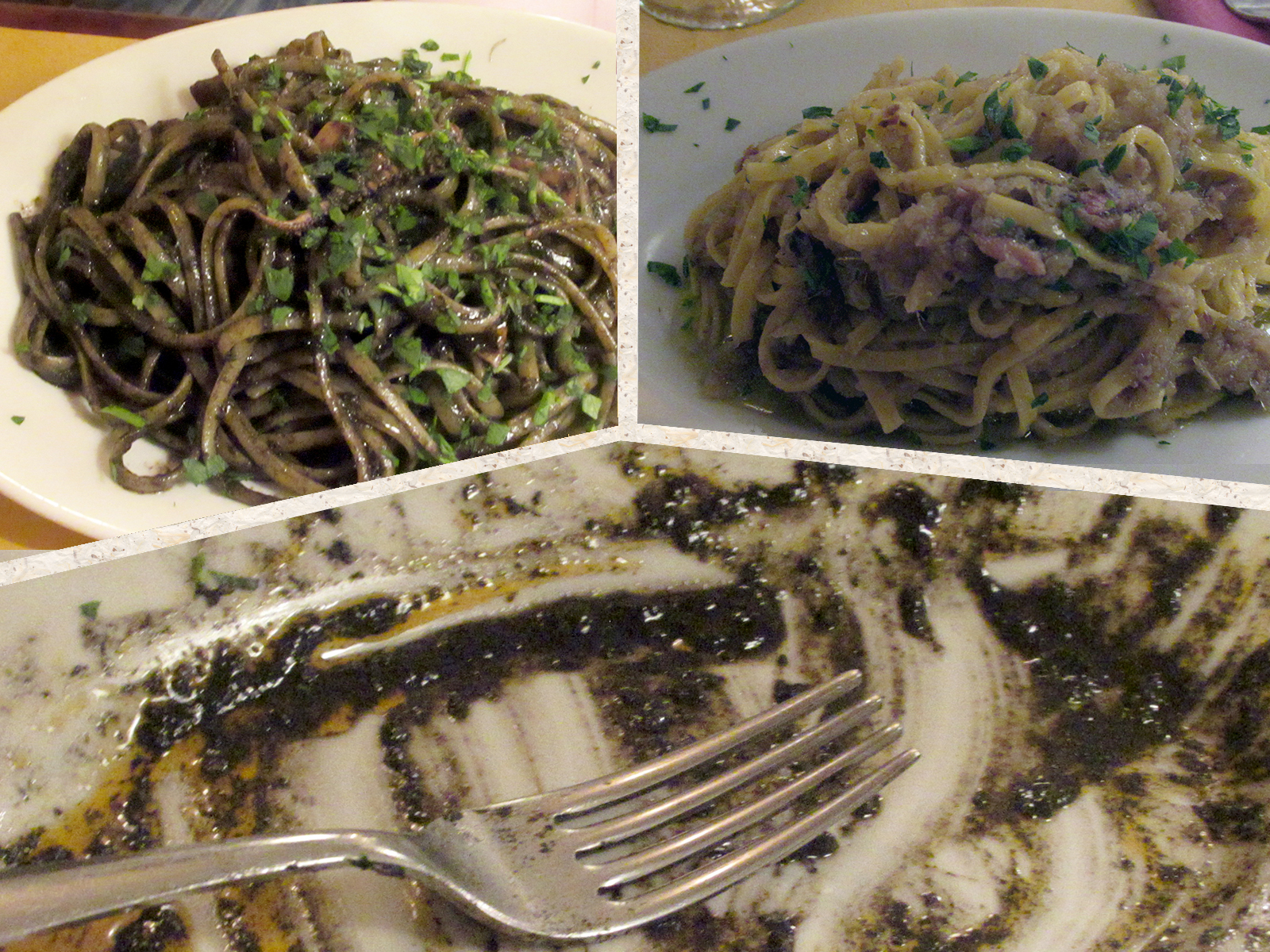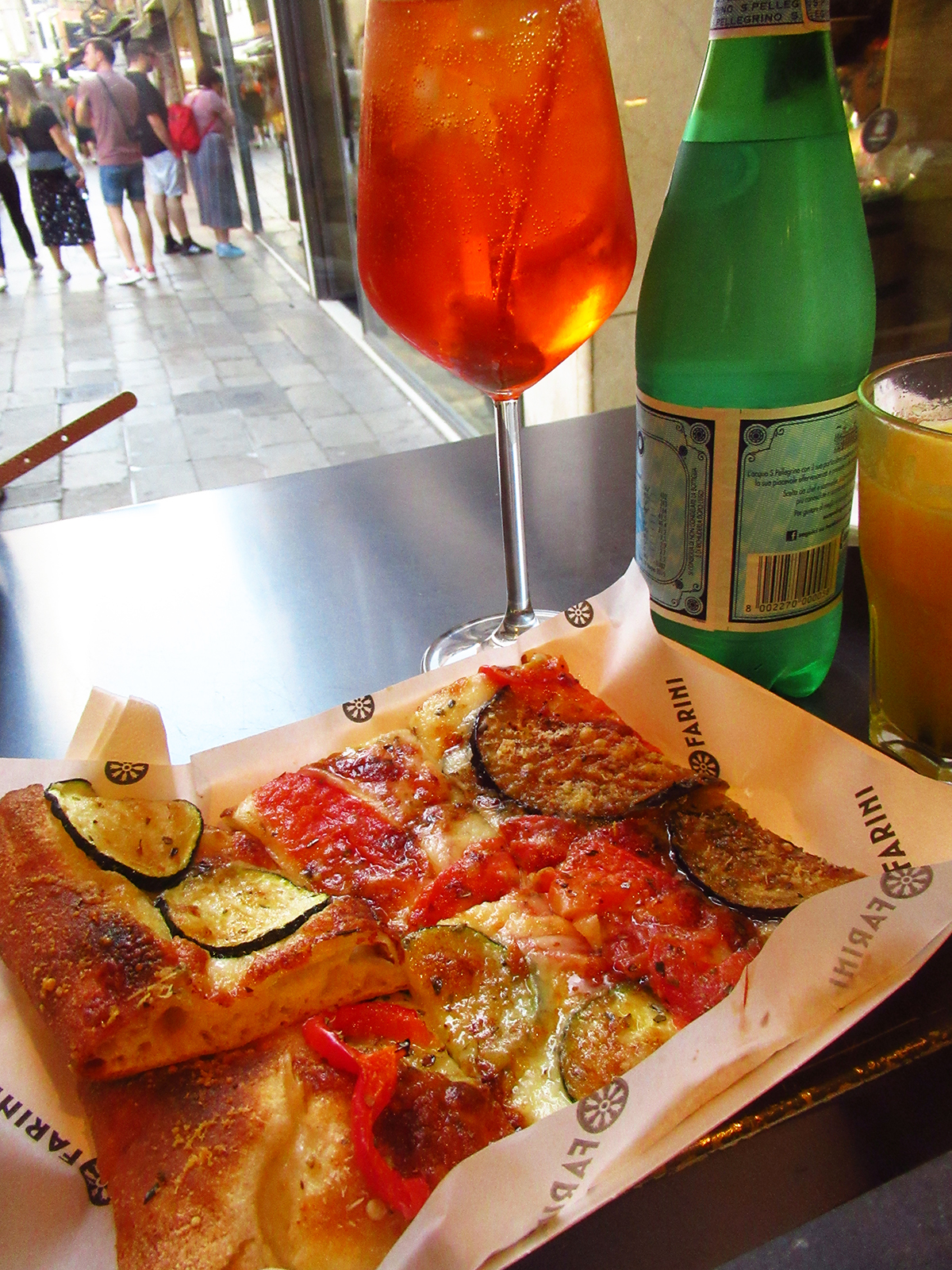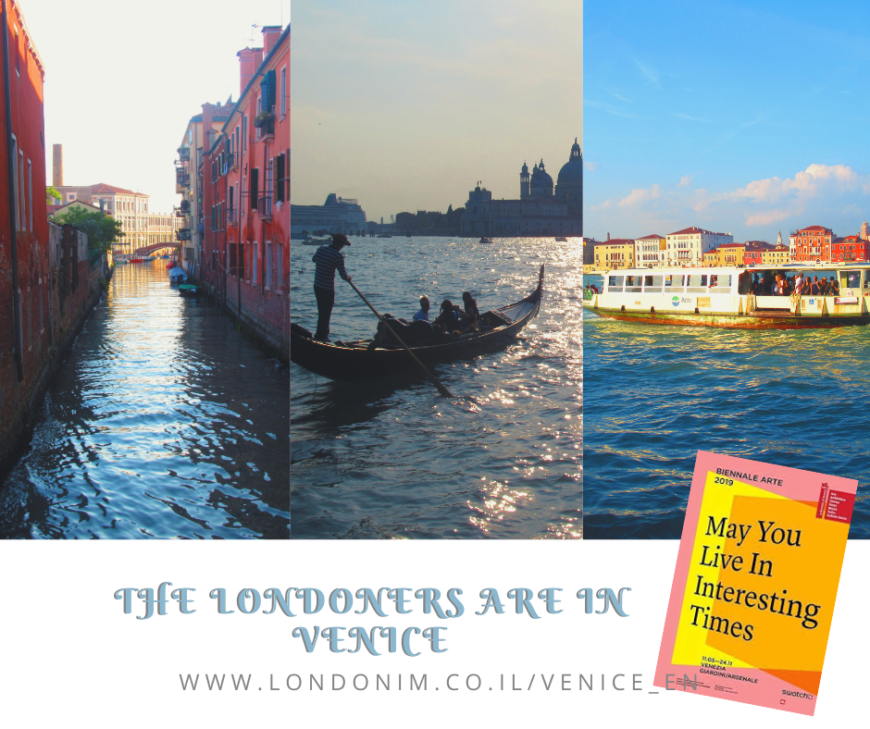
“Venice? With the kids? Have you lost it completely?” was the average response we received from anyone we told about our intention to spend the long weekend in the City of Canals .
Nonethless, the Venice Art Biennale comes once every two years, and it’s been six years since the Londoners have been here last (when the little-big Londoner was still a bun in the oven). Plus, we were finally able to book a reward flight for free – so what’s there to lose? (Spoiler: A lot of back-aches…)
The Londoners pack up half a house, three kids and a buggy, and hop over to Venice (a long post with lots of photos)
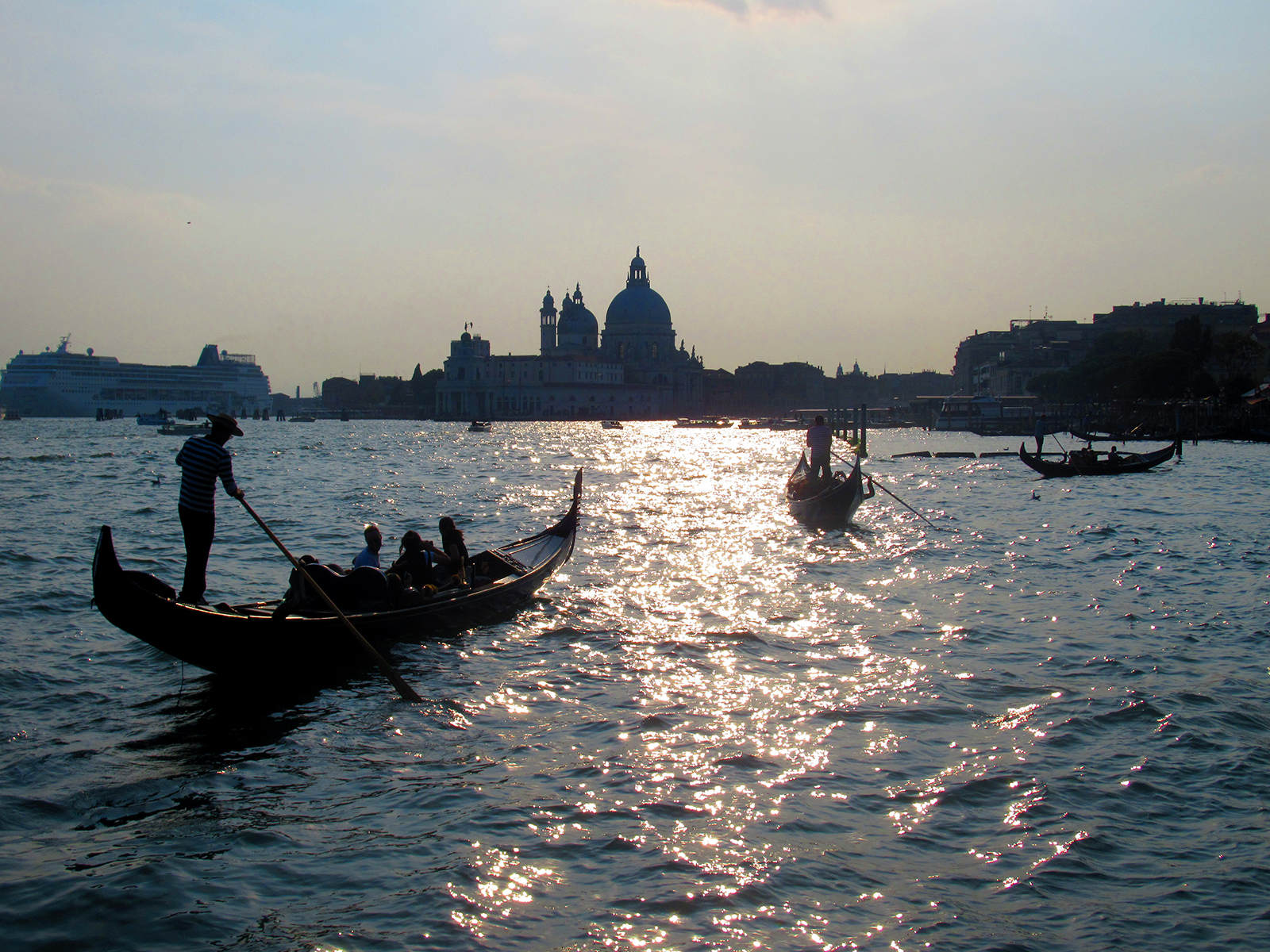
While in London summer is already over, we board an Uber and arrive at London City Airport, in the middle of the night. The lovely little Airport is located near the docks in east River Thames, and if we didn’t have little ones and an overly packed luggage, we would have simply taken the tube. As the small BA aeroplane breaks through the clouds, the “why the heck did we need this” feeling is overtaken with the excitement of the kids, who will, for the first time, see “The City of Water.” What we adults take for granted, the little ones questioned quite a lot beforehand … Pretend you were offered a ticket to the lost city of Atlantis?
An hour and a half later and we land. A 10 minute walk to the boat docks, and we find the pre-booked water-taxi (the most expensive expense of this trip, which we wouldn’t have dared spend six years ago). On board the boat, which is already skipping over the waves, the fears of the little ones are exchanged for excitement, and even the parents forget the logistical nightmare. Venice here we come!
This post is made of categories, each represents one of our days. If you can’t bear our jabbering (that’s okay – we’re not offended) – just go straight to the interesting part – the food.
The Venice Biennale
So what is the Venice Biennale for Art and why is it such a big deal, you ask?
La Biennale di Venezia takes place once every two years (the name is originally derived from “Bi-Annual”) and had been held in Venice continuously since 1895 (except during the two World Wars).
It is important to note that there is also a Biennale for performing arts and cinema, which are held at other times.
The Biennale was originally intended to promote modern art and art-works sales, but this aspect was cancelled in the late 70s, since which the Biennale has become solely an exhibition venue. It is one of the world’s largest and most prestigious art exhibitions, which every year is curated by a different renowned artist, curator or art critic. The curator is in charge of the Central Pavilion at the Arsenale complex and the various events. This year, Ralph Rogor, American curator and the director of the well-known Hayward Gallery was invited to hold this high position.
Originally, six countries participated in the Biennale, a number that grew significantly over the years, while more and more countries have been invited to set up pavilions, aimed at presenting an artistic display that reflects the respective country’s culture. This is considered a high honour for each artist, and usually his/hers invitation marks a milestone in his/hers career. Most of the pavilions are located in the Giardini – the gardens – with free water-taxi service floating between the compounds. There are also free golf carts which help drive around visitors who find it difficult to walk around the Biennale.
A daily ticket to the Biennale will cost you € 26.5 or € 17.5 for young persons and € 21.5 for seniors above 65. A 3-day Plus ticket for as many entries as you want, costs € 36.5 (€ 26.5 for students) . The Biennale is closed on Mondays, and this year ends on November 24
“Anthea Hamilton’s work, “A new life
The Vaporetto – the only way to travel
Before we get started, it’s also important to explain how to move around Venice. In fact, there are three ways in which you can move from place to place in The Floating City (with the exception of the gondolas, which are for tourists only): 1) Walking between the crowded city alleys and packed bridges 2) Water-taxi – motorboat taxis that can cost a considerable some of money and 3) our love – The Vaporetto , or the Water Bus. One-way ticket anywhere costs € 7.5, while a 3-day ticket costs € 40 . There are stations everywhere, and once you understand the direction of travel and that one needs to push a bit at times in order to board (There’s no room for English politeness here!) you will find that this is the best (and cheapest) way to travel around Venice.
Some Vaporetto tips: The team is made of a skipper and a crewman responsible for docking and order. Take off your backpack – it freaks them out for some reason. Save the seats inside, there are also seats in the stern, and a lot of people just stand on the deck. The smaller Vaporettos also have seats at the bow. There is a chance you will feel the motion of the Vaporetto even a week after you get back home, this is a phenomenon called MDDs (if it continues beyond a month – go check it out!)
Day ONE
Right after getting organized, and sorting out some issues with our hotel room (there’s always something, right?), we took off to the Biennale, the Giardini grounds. When traveling with an art loving Londoneresse (who also organized a tour of the Biennale six years ago), with three impatient Londoners and a baby girl, compromises must be made. Therefore – the Londoneresse understood that the days in which she surveyed every pavilion for hours, are over. Instead, we must embrace times during which, repeated breaks have to be made, as well as offering gelato bribes at least once or twice a day.
The Canadian pavilion featuring the Inuit (Native American) narrative was boring for us, while the queue for the British pavilion was too long. The Israeli Pavilion, which is made to look like a waiting room for a field hospital, requires patience – they ask for about an hour of your time, for which we can only say in our best Italian: “get real buddies!”. The American Pavilion (artist Martin Puryear) is well liked by the little ones, who get the chance to climb a dragon tail-like statue. The Japanese pavilion as well, with an orange circular airy seating sofa that immediately became a destination for head jumps.
Wanderings around we calmly look for the lavatories (or in reality: a frantic run with the little-middle Londoner who had to go). That ended well enough. The kids got a first gelato (Italian ice cream) at one of the Biennale’s Cafes, and we even had a chance to sample a few more pavilions before the hotel rang to say that the room was ready.
Contrary to the past, when we stayed in small and crowded hotels nestled in the alleys of Venice, the Londoners decided to opt for a hotel in the eastern neighbourhood of Sant’Elena would be easier, especially since we can walk to the Biennale on foot. The decision turned out to be a good one, especially in view of the hotel’s close proximity to the Vaporetto stop and to a playground, which (unfortunately) won a daily visit.
A quick rest in the room and a Vaporetto ride to the Rialto Bridge, where we find ourselves in an art show that is not part of the Biennale (yes such is the Londoneresse, a tireless database of exhibitions). PERSONAL STRUCTURES – ART EXHIBITION – Palazzo Bembo is an exhibition by an organization called “Personal Structures” aimed at combining philosophy and art discussions. In practice, there’s little of philosophy along very impressive rooms, including the plastic reef room, which the little-big sister Londoner particularly enjoyed. The little-medium Londoner fell asleep on the Vaporetto, and got up in a fairly grumpy mood.
Federico Uribe’s Coral Reef
A word about the Rialto Bridge : Most likely the most impressive structure in Venice, the Rialto was built in 1181 as a wooden bridge that could be lifted, in order to allow war-ship passage. The tax collected from the shops on the bridge was intended for its upkeep, and to this day it is characterized by a multitude of souvenir shops along its footpath. In 1591, the bridge was rebuilt from stone, in an impressive single arch. Besides it (on its west bank) is the Rialto Market specializing in fish and seafood. The bridge is made of stairs and its span is 31.8 meters (7.3 meters high), so if you climb it three times carrying a pram and survive – you have better stamina than you have thought.

For dinner, the Londoneresse takes us to a well-known Venetian institution called Cà D’Oro alla Vedova (It is actually our second time here together). This restaurant specializes in seafood pasta dishes and, moreover, in freshly fried polpette dish (meat balls) that everyone, but EVERYONE, is eating standing in the alley that leads to the restaurant, along a glass of Prosecco. The kids ask for pasta, and are downing it in ketchup which we brought in. The adults eat polpette and pasta with squid and black ink and one with tomatoes, garlic and anchovies. More on that in the “the Restaurants Parade” later on. The little ones are not happy and we have to finish tonight with another meal at the only McDonald’s on the island. “You win some you lose some … “
Day TWO
The 2nd day starts off at the Arsenale compound, to the displeasure of the little ones who want their gelato as early as 11 am (“Yesterday’s compromises are today’s norms”). Somehow, we manage to drag them between the exhibits, and slowly the animosity toward the parents fades, as they find out that there are all kinds of art installations that can even be enjoyed. Amongst which: the chair and moving hose (see below, by provocative Chinese duo Son and Feng), or the hearts and lungs and emoji made from 3D projections. In general, it seems that if you skip the video arts (a genre of which the Londoners are not great enthusiasts), we can skim through relatively quickly, so that even the little ones maintain a high level of interest.
“Sun Yuan & Peng Yu. “Dear

We leave the Biennale thanks to the kindness of a golf cart driver who agreed to take us for a ride back to the entrance, or as the little-big Londoner (hitherto grumpy because of the lack of ice cream) describes it as “BEST DAY EVER”. We take Vaporetto to the island of Giudecca because there is some art installation “we simple must see” at the Icelandic Pavilion (- the Londoneresse, October 2019). Although the Biennale is mostly concentrated in two compounds, you will discover (that is, if you really looked into it) that there are pavilions scattered throughout Venice, that an arduous journey must be undertaken in order to reach them. Among them: The Icelandic, Lithuanian and New Zealand Pavilion. Why? Only God and Ralph Rogoff have the answers.
Some believe that the island of Giudecca is named so due to the Venetian Jewish merchants who lived there, and historical evidence of an ancient synagogue which was found there. However, the Venice Jewish ghetto was in the north of the city and therefore the above explanation does not satisfy most scholars. Others believe that the name Giudecca is derived from the word Zudegà – meaning “Judged” or “punished”. This explanation attributes the name’s origin to the punishment of exile inflicted upon noble Venetian families in the 9th century. Another explanation suggests that this is a disruption of the Venetian word for leather tanning, as this was the main occupation of the islanders here. Either way, Giudecca is a beautiful residential neighbourhood, with picturesque alleys and a pastoral pier, which doesn’t resemble messy ‘downtown’ Venice.

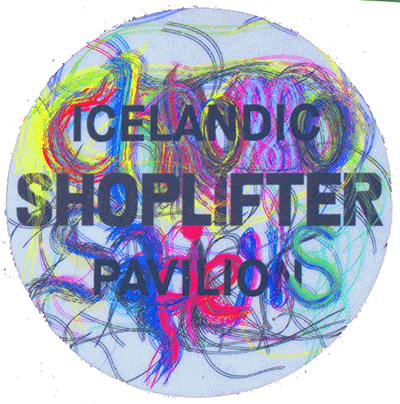
The Icelandic Pavilion – Chromo Sapiens – showcases the work of artist Hrafnhildur Arnardóttir. An Icelandic native who grew up in NYC, her name distorted by the locals to ‘Shoplifter’, a name she uses to this day.
The artist loves to work with synthetic hair. No kidding! We actually found scraps of her work in our clothes, even later in London. The atmosphere in the pavilion – which is not crowded due to the remote location – is calm, with appropriate music that can also be purchased on the spot. The walk here was calm for all (with the exception of a the little-middle Londoner who refuses to walk since the early morning) , in the pavilion itself the rascal manage to ‘find his feet’ and the little ones disrupted peaceful atmosphere.
The entrance is dark, the main room is rainbow-coloured, while the back room is made of white hair that the little ones nicknamed the “North Pole” in some made-up game they were playing to the dismay of the other visitors.
After crossing the spectacular Academy Bridge, we realised that the place booked for dinner (which the Londoneresse remembered from 6 years ago) was no longer specializing in Branzino (an Italian version of Cod/Bass) and that the prices here are very high. We instead had A surprisingly good meal at Da Fiori restaurant. Adjacent to the place there is a bar (Bacaro) that, like “Alla Vedova”, specializes in polpettes of all kinds. We also got acquainted with a drink called Sgroppino made of lemon ice cream, vodka and prosecco.
The children were very tired, and it was hard for us to keep them concentrated without causing property damages, so we settled for red wine.
Returning to the hotel, we were able to get the bartender to make us his own version of Sgroppino while the kids were passed out on lobby sofa (please do not share this with the English child-welfare authorities). Here’s the classic version of the drink shot at the restaurant, or: In a word – Yum!

Day THREE
It’s wouldn’t be Venice without visiting St. Mark’s Square (Piazza San Marco), the only public square in Venice (note in Italian Piazza and not Campo). We pat ourselves on the back that we have managed to hold up ’till now, and arrive here on Monday, when the Biennale is closed.
The square is particularly recognized for the Basilica opposite to it, and the Doge’s Palace (the old Duke / ruler of Venice) facing the sea. Today, it seems that the weather is smiling to us again – however workers are preparing for “Acqua Alta” by placing wooden beams on the square’s pavement. At least once a year, the level of water rises, which makes the square one big dangerous pool. This square also hosts the opening ceremony of the annual Venice Masks Festival.
A few photos for the old family album, leisure activity of chasing pigeons around (which becomes the national sport of the little Londoners) and we begin to wander the crowded alleys next to the square, home of Venice’s luxury stores, jewellers, elite fashion brands, and the well-known Murano glass.

Our stroll leads us in the direction of the Rialto (not again!), not before the little-middle Londoner makes us enter a Candy Captain’s branch, to buy some “Gummy Gums”. Since this holiday is comprised of pasta and gelato nutrition, the reluctant parents agree, and he comes out from the shop triumphant with a paper bag which contains a Doge-palace-sized gummy-bear.
An unsuccessful visit to the post office … The little-big Londoner insists on sending a postcard like old times to her grandparents (even though she had only heard about this strange ritual on this trip).. By the by, about two weeks later and we still haven’t heard from the grandparents about a postcard coming, Bravo to a post-Italian !! We cross the Rialto (please leave us a good chiropractor’s details in the comments) and we enter the Fondaco dei Tedeschi to see the exhibit on the rooftop (yes, yes, the Londoneresse, ‘nuf said?).
The Fondaco dei Tedeschi is a high end shopping mall, near the Rialto. It is designed impeccably. Not many know that beyond the fancy shopping and brands, the fifth floor has a roof with a breathtaking views of Venice. Generally, it’s free but you need to book in advance, but in Italy as in Italy, cute babies and a smile will get you far (it’s not England here
T Fondaco dei Tedeschi by DFS, Calle del, Ponte di Rialto
To prebook: https://www.dfs.com/en/venice/t-fondaco-rooftop-terrace
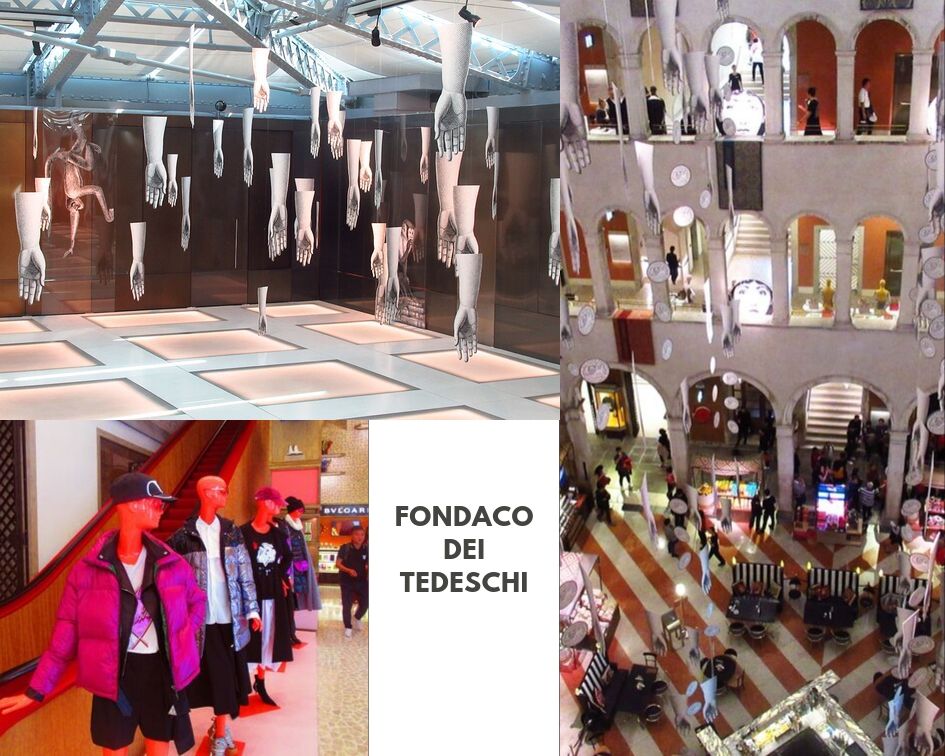
Here, the stomach started rumbling, and in order to accommodate everyone’s culinary taste we are compelled to stop for food, at three, correction – four different places. Farin for pizza for the the men and an Aperol-Spritz for those who already graduated from primary school; Burger King for the little-big Londoner who still refuses to eat pizza; Cafe del Doge for the best coffee in Venice (see below), and obviously the long overdue daily gelato.
Another crossing of the Rialto Bridge (Mamma-Mia!) and an unexpected meeting with a friend from the Londoner’s army service, who was with her family, having just returned from a trip to Dolomite Isles (yes, yes, this also happens in Venice!). At this point, three-quarters of the group members (those who know how to talk anyways) rebel and refuse to go on to the next artsy destination. We schedule to meet for dinner at a home-styled restaurant located in the quiet neighbourhood of Castello, and prepare ourselves for the fourth day that will conclude with flying back home.
Day FOUR
Our final day started in a rush: quick breakfast, and off we go to navigate through the alleys of the Arsenale area, in an effort to reach the elusive Lithuanian pavilion. The walk to the pavilion, which included carrying the little-middle Londoner (he’s done with walking for the remainder of this trip…), was tough, and the noise of the Londoner’s heart breaking in light of the disappointing pavilion, could have been heard all the way to Saint Mark’s Square.
The Artist have setup a (dirty) beach, and it just wasn’t that exciting. Perhaps this pavilion is more appealing on Wednesdays
and Saturdays when actors perform and sing live opera on this beach. However, we have heard that the queues on those days are accordingly long.
From there we head out to the remote area of Celestia, trying to find “Building Bridges”, a monumental sculpture by artist Lorenzo Quinn, who already impressed the last Biennale goers with a statue of gigantic hands gripping a building. We saw the spectacular sculpture abruptly on the water-taxi on our way to the hotel, and being near it doesn’t disappoint: rows of hands holding hands, each doing a different gesture, big enough to allow a boat to sail through the hand-made arches. Impressive! The walk to the sculpture is difficult, but we discover that it is actually part of another compound of the Biennale which many people miss. A free boat can be taken back from here to the Arsenale.
Back at the Biennale, we board the free golf cart yet again, a savvy way to get us out of here, and we head out to Via Giuseppe Garibaldi. The picturesque street is different from the usual Venetian landscape and looks like a typical Italian street. The last gelato dose (if anyone actually counted how many there were, please don’t tell our parents) and we stop at the overcrowded Coop supermarket to stock up on carbs that we can’t easily get in England.
From here we will return to the hotel, sit down for a last coffee in Sant’Elena, and take the water-taxi back to Marco Polo airport.
The Restaurants’ Parade
Right, so here’s what we managed to eat here with two toddlers, a baby (and yes, a ketchup bottle in our bag, what can we do….)
Cà D’Oro alla Vedova
Ramo Ca’ d’Oro
+39 041 528 5324
As mentioned, “Alla Vedova” is a favourite of the Londoneresse, since her days as a student in the city of bridges. This is a restaurant that has been around for over twenty years, specializing in seafood pastas and freshly fried Polpette, that most punters simply eat standing outside the joint, along a glass of Prosecco. If you happen to have won a table, you will find the same polpette (which looks a falafel ball and is delicious like a meatball) served inside, alongside seafood salads, and vegetarian and seafood pastas.
Sampled: The Famous Polpette, pasta with Squid in Black Ink sauce (a Venetian dish known as Risi e Bisi) and pasta with Tomato, Garlic and Anchovy Sauce. Everything was excellent!
Trattoria / Bacaro da Fiori
Calle de le Boteghe
+39 041 523 5310
http://www.dafiore.it/
The Londoner’s disappointment from the menu of the restaurant that specializes in Branzino led us to roam the alleys near Campo Santo Stefano and so we found Da Fiori, which in retrospective, was also recommended to us by a number of people. Next to the restaurant there’s a polpette bar like the one in Alla Vedova (Bacaro), only here it serves a few types of the meatball: meat, fish, vegetarian and more.
We ordered the house wine, as well as fish, since this is the house speciality. The seared tuna was excellent, as was the bass pasta, though we wondered if we ought to have ordered the bass “three way” which was the closest thing to the coveted branzino. A Caprese Salad with red and yellow cherry tomatoes was just okay, and as mentioned above, we got acquainted here with Sgroppino – a drink made from lemon sorbet, vodka and prosecco (scroll up for a video). A highly recommended restaurant!
Farini
farini.com
We reached Farini by mistake, then again by mistake, and then again, until we realized it was a chain, and we didn’t really stroll around in Venice, walking in circles … As we adore Princci in London we had to try Farini, which is quite similar: fresh pizzas, pastas, classic Italian desserts and of course Aperol Spritz and other kinds of alcohol. Service is very quick, and not very eco-friendly with disposable cutlery and plates, but it’s quick and tasty. In fact, everyone (except the little-big Londoner) found something to eat in Farini.
Caffè del Doge – Caffetteria Rialto
Rialto, Calle Cinque, 609
Cafe Del Doge, which the Londoneresse remembers from her days as a student in Venice, is a small café, walking distance from the Rialto Bridge, in a shabby alley. We spent here our daily breakfast six years ago, when we stayed in a Cold War espionage era hotel, which was just a shoestring away the sleepy café. In fact, Cafe Del Doge is not only a coffee shop, but a roasting company of fine Italian coffee, served in a large number of cafés in the area. This is the original and only branch.
This is a place for coffee nets, maybe some small cookie on the side, but not much more than that.
Osteria da Pampo
Calle Generale Chinotto, 24 (Sant’Elena)
+39 041 520 8419
osteriadapampo.com/
Ostria Da Pampo is a small family restaurant in the Castello district, to which we came quite by accident. The reviews on the Internet praise this small corner establishment with a garden, and it seems its ideal for romantic meals. But when the little ones are imposing a bad mood after an intense day of wandering around, nothing seemed to have worked: the shape of the pasta they received, the bread or the ketchup. At this atmosphere – even the most inviting meal may turn into a nightmare.
That’s what happened to us at Ostria de Pampo: the waiter and waitress were very nice, but it just didn’t work.
The mixed sea food starter consisted of sardines that were sweetish (a Venetian dish but not as tasty as the fried sardines that we envisioned), prawns, cold bass, and Bacalà Mantecato which is a Venetian dish that is essentially white pickled fish-mash. It may be a good dish usually, but it was quite tasteless.
The Caprese Salad was a bit coarse, the bass fillet was just okay, while the best dish was the beef ragu pasta – not very typical to Venice but was generous and delicious. It’s hard to recommend a place whose signature dish – a sort of seafood lasagne – we saw was heated in the microwave a number of times … really, we tried.
Nearly four days of holiday in Venice passed by so quickly, that we hardly remember we were there. Thanks to the fact that the Londoner still feels like he is on a Vaporetto we know it was real. Venice is changing, surely one of the world’s most touristic cities is slowly catching up with rest of the West: a travel app for the Vaporetto, refurbished docks for the water-taxis in the airport, supermarket chains such as Coop, and more. The Biennale like the Biennale is still the best art show in Europe, especially in slightly less interesting times.
A “Blessing” originates from a Chinese proverb wishing “May you live in interesting times” is this year’s Biennale’s moto. The intention is ironic – since it is known that precisely uninteresting periods in history (such without conflicts and wars) – are the ones in which life is the best …. In Venice, however – things are never Boring! fino alla prossima volta!


